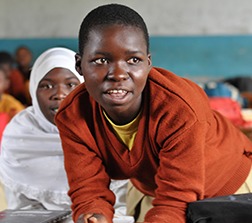- About
- Topics
- Picks
- Audio
- Story
- In-Depth
- Opinion
- News
- Donate
- Signup for our newsletterOur Editors' Best Picks.Send
Read, Debate: Engage.
| August 20, 2022 | |
|---|---|
| topic: | Child rights |
| tags: | #Africa, #education, #conservation, #endangered species, #child rights |
| located: | Democratic Republic of the Congo, Tanzania, Uganda, Zambia, Ethiopia |
| by: | Bob Koigi |
Rural Africa is home to numerous marginalised communities struggling to access education. In Sub Saharan Africa, for instance, more than one fifth of children between six and 11 years and as much as 60 percent of young people between 15 and 17 do not attend school.
At the same time, some of Africa’s rural areas are home to precious natural resources. But with limited to zero education access, children growing up in those areas are prone to relying on economic activities that harm the environment in order to eke a living, such as felling trees or engaging in wildlife hunting.
In order to foster conservation of natural resources and ensure that children grow up appreciating the value of the nature that surrounds them, a project has been rolled out in some of the remotest areas of Africa. The project is reportedly generating a conservation revolution, introducing employment opportunities and cultivating sustainability beyond the classrooms.
Dubbed Classroom Africa, the programme is chaperoned by The African Wildlife Foundation (AWF), and has been in existence since 2013. It takes credit for having built six modern schools in areas identified as requiring conservation efforts, equipping more than 2,000 students with education each year and protecting over 220,000 acres of forests and wild lands through special agreements with local communities.
The schools are spread across Democratic Republic of Congo, Ethiopia, Uganda, Zambia and Tanzania.
The programme does not build new schools, but rather upgrades existing ones, and selection of beneficiary schools is determined based on the organisation’s conservation strategy in the area of focus, the availability of a conservation team on the ground and the relationship with local communities.
Once a school is identified, the staff of Classroom Africa work with local leaders, parents, education officials, teachers and students to identify the school's infrastructure needs. Local architects are then consulted to design refurbished or new buildings while considering the needs of the community and local climate. Local labour is used in the construction process.
"The choice of schools is driven by AWF’s conservation strategy for that landscape," states AWF. "Chiefly, we assess ecosystem threats and whether the schools have meaningful needs that Classroom Africa can address. We also determine whether engaging the school will lead to improved community participation in conservation."
While AWF builds schools, employs teachers and invests in imparting conservation knowledge to students, community members commit to certain conservation actions and deliverables christened the conservation covenants.
The real investment, however, is in the conservation education. AWF invests in training teachers and incentivising them through inducements like the construction of houses for them near the schools. After every school term, Classroom Africa staff members conduct follow ups with all schools to review the students’ performance, while carrying out baseline and follow-up surveys to test the students’ knowledge on matters of conservation.
According to the organisation, historical data has shown that the programme’s support has not only bolstered students interest in conservation, but also improved their overall academic performance.
In Ethiopia, the programme has been working with Adisge, a rural community living next to the Simien Mountains National Park.
The park is home to rare and endangered species, including the gelada baboon, walia ibex and the Ethiopian wolf. Partnering with Ethiopian Wildlife Conservation and tourism ventures, the project rebuilt Adisge Primary School and invested in intensive conservation training.
This played a crucial role in rehabilitating the protected area and saw the removal of the park from the World Heritage Site Danger list.
In Zambia, students from Lupani Community School have benefitted from classroom training and field trips, especially to Victoria Falls and Mosi-oa-Tunya National Park. Inspired by the training, the students have constructed a greenhouse with 1,500 tree seedlings, an initiative that is going a long way in reforestation drives within their communities.
"Our larger goal is to positively engage schools and children for long-term impacts on conservation success in a landscape," AWF stated.
"Serving more students and teachers will enable us to reach many more young people at a time when Africa is experiencing dramatic growth in population as well as economic development, including new infrastructure.
"We seek to help mobilise a new generation of young conservationists who will demand meaningful conservation change and commitments from their elders and peers alike."
Image by Seth Doyle.
By copying the embed code below, you agree to adhere to our republishing guidelines.

